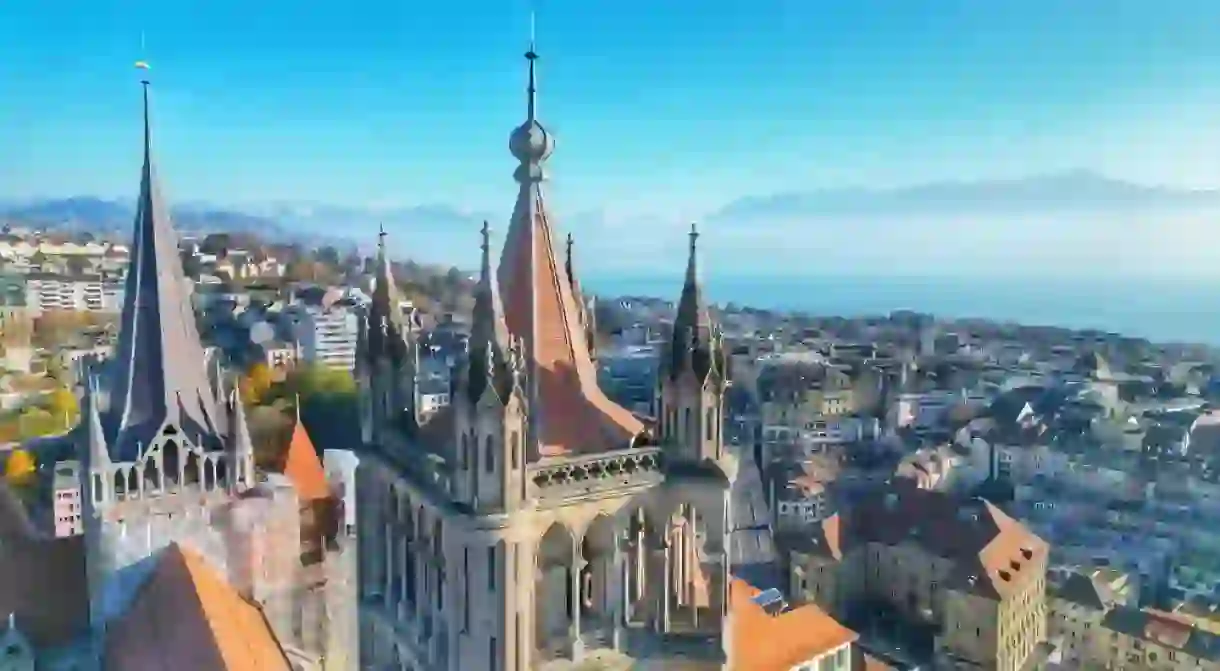Top 10 Things to See and Do in Lausanne, Switzerland

The lakeside city of Lausanne is small, picturesque and well-known. From its famous polytechnic university (EPFL) to its Olympic Museum, there are no shortages of sights to see. Read our guide to exploring the best of what this green and quaint city has to offer.
Cathédrale de Notre Dame
Historical Landmark
The Cathedral of Notre Dame is a stunning Gothic cathedral, and arguably the finest cathedral in Switzerland. It was built in the 13th century and Pope Gregory X and several cardinals and bishops sanctified the cathedral in the presence of the Habsburg Emperor, Rudolph in 1275. Be sure to look at the beautiful rose window which includes paintings of the Zodiac signs and various elements. The cathedral is situated at the heart of the vielle ville, the Old Town.
Parc de Mon-Repos
Park

The park of Mon-Repos was built as an English-style park in the 18th century. It has a long list of impressive features including an aviary with over 70 species of birds, natural decorations such as an orange grove and a waterfall, and an impressive neo-Gothic tower (pictured above). In the summer, the Park is home to several events, such as outdoor film screenings and musical performances.
Château de Saint-Maire
Originally the home of bishops, the 15th century Château de Saint-Maire is now used to house government offices. The turreted castle was commissioned to be built by Italian architects in the Ghibelline style of the period. It is located on top of the hill, but it’s well worth the walk to admire both it and the fantastic views it commands.
Collection de l'Art Brut
Museum
The collection of Art Brut is a gallery with a difference. Made entirely by untrained artists, the art reflects a certain dissonance. These artists came from prisons, orphanages, asylums, etc., places not typically reflective of curated art. There are now over 60,000 pieces of art in the collection, internationally renowned and carefully conserved by the museum’s curators. The collections are now housed in the specially built grand galleries of Château de Beaulieu.
Chalet-à-Gobet
Hotel

A little outside of Lausanne, but still in the canton of Vaud, the town of Chalet-à-Gobet marks the watershed area between the Rhone and the Rhine rivers. It’s worth an excursion to it to see the Lausanne Hotel School, which trains students in formal Swiss hospitality, and the Golf Club of Lausanne. During the winter months, it’s frequented by families with children, who enjoy skiing on the slopes. There are also areas for snowshoeing and sledding, making this an ideal getaway from the city.
Port Ouchy
The port of Ouchy, on the shores of the Lake Geneva, isreminiscent of the promenade along Nice, or other South of France rivieracities. The entire span of the Promenade encompasses three gardens: the Denantou, the Elysée, and the Olympic gardens. Walk along during the daytime to enjoy the tree-lined walks and the abundant flowers; or if you happen to stop by on the 1st of August, Swiss National Day, you’ll see a grand display of fireworks. A local favourite activity is to rent a pedalo and explore the waters.
Olympic Museum
Museum
First established in 1993, the Olympic Museum is the largest of its kind in the world. It’s a highly interactive museum, with lots of screen displays to encourage you to explore the museum as much as you’d like. The Museum has the Olympic Torches of all the Games played so far, and it also keeps the pieces of equipment that the athletes required to win their gold medals. Opening hours: 9.00am – 6.00pm daily (1 May-14 October); 10.00am – 6.00pm, closed Monday (15 October-30 April)
Jardin Botanique
First set up in 1824, the Botanical Gardens in Lausanne house a large number of botanical collections. There are over 6000 plants here, including flowers, other flowering plants, ferns, algae, fungi, etc. Many of these are Alpine plants, and several have medicinal and remedial qualities. Be sure to stop by these for a relaxing afternoon learning about the plants; there are several informational placards placed around the area.
Place de la Palud

Located in the city center and just off the Cathédrale de Notre Dame, the Place de la Palud is a draw for locals and tourists alike. This wide, cobblestoned square has little cafés and restaurants that give it that classic streetside European relaxed atmosphere. There is also a beautifully painted fountain known as the Fountain of Justice. The great novelty of this square, however, is the mechanical clock that tells the history of Vaud through its small historical vignettes.
Parc du Désert
The Parc du Désert is located on the outskirts of Lausanne, but well worth the small trip. Contrary to the implications of its name, the garden is actually lush and green, and beautifully landscaped. Unlike other Romantic-style gardens in Lausanne, it is a baroque-style garden that dates back to 1782, a few years before the French Revolution. It has a large vegetable garden, small enclaves and groves of lime trees, and is geometrically patterned in the typical Baroque fashion.













